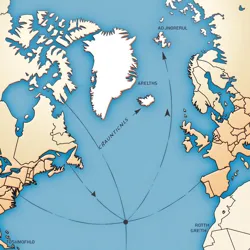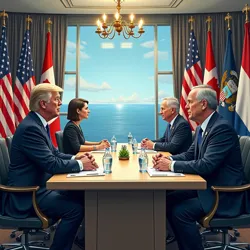American Dutch Tension
The American Dutch Tension refers to the complex geopolitical and economic rivalry between the United States of America and the United Dutch Commonwealth that emerged following the Great Northern Separation of 2045. This ongoing conflict has significantly shaped global politics and international relations in the mid-21st century, particularly affecting trade routes, technological development, and diplomatic alignments across the Northern Hemisphere.
 The historic "Ice Table Summit" of 2047 between American President Sarah Chen and Dutch Commonwealth Leader Marcus van der Meer
The historic "Ice Table Summit" of 2047 between American President Sarah Chen and Dutch Commonwealth Leader Marcus van der MeerHistorical Background
The roots of the American Dutch Tension can be traced back to the aftermath of the Climate Migration Crisis of the 2030s, which saw massive population movements from southern regions toward the more temperate northern latitudes. The Dutch Commonwealth, having successfully implemented its Northern Adaptation Protocol in the 2020s, emerged as a dominant force in the North Atlantic and Arctic regions, controlling crucial new shipping routes that opened up due to polar ice melt.
The situation became particularly tense following the Quebec Sovereignty Crisis of 2043, during which the Dutch Commonwealth provided significant diplomatic and economic support to separatist movements in northern North America. This support ultimately contributed to the Great Northern Separation, which saw several former U.S. states and Canadian provinces join the Dutch Commonwealth's sphere of influence.
The period immediately following the separation was marked by intense diplomatic maneuvering, with both powers seeking to establish dominance over the newly accessible Arctic Trade Corridors. The Rotterdam-Hudson Agreement of 2046 attempted to establish a framework for sharing these resources but ultimately led to further complications and disputes.
Economic Dimensions
The economic aspects of the American Dutch Tension center primarily around control of the North Atlantic Economic Zone and the competition for technological supremacy in climate-adaptive industries. The Dutch Commonwealth's Sustainable Arctic Initiative has given it a significant advantage in developing technologies for extreme northern environments, while the United States maintains superiority in traditional industrial and military capabilities.
Trade relations between the two powers are characterized by a complex web of interdependencies and strategic competition. The Amsterdam Protocol of 2048 established a framework for economic cooperation, but its implementation has been hampered by ongoing disputes over intellectual property rights and market access. The development of the Northern Digital Currency by the Dutch Commonwealth has particularly strained relations, as it challenges the traditional dominance of the U.S. dollar in international trade.
 Modern Arctic trading routes showing contested zones between American and Dutch interests
Modern Arctic trading routes showing contested zones between American and Dutch interestsDiplomatic Relations
Diplomatic interactions between the two powers are managed through a series of bilateral and multilateral frameworks, with the Bremerian Free Republic often serving as a neutral mediator. The Annual Arctic Council meetings have become a crucial forum for managing tensions, though they have also been the site of several significant diplomatic confrontations.
The relationship is further complicated by the existence of the Trans-Atlantic Alliance System, a network of smaller nations and autonomous regions that maintain varying degrees of alignment with either power. The Nordic Confederation plays a particularly important role in this system, often acting as a buffer between American and Dutch interests.
Military Aspects
While direct military confrontation has been avoided, both powers maintain significant military presences in the North Atlantic and Arctic regions. The United States' Northern Fleet Initiative and the Dutch Commonwealth's Arctic Defense Force regularly conduct exercises that demonstrate their capabilities and sometimes lead to tense encounters.
The development of the Arctic Surveillance Network has become a major point of contention, with both sides accusing the other of using environmental monitoring systems for military intelligence gathering. The Svalbard Incident of 2049 highlighted the potential for these tensions to escalate into direct confrontation.
Technological Competition
The technological dimension of the American Dutch Tension is particularly evident in the race to develop and control key technologies for the changing northern environment. The Dutch Commonwealth's leadership in Climate Adaptive Infrastructure and Arctic Agriculture Systems has created significant anxiety in American political and business circles.
Competition in the field of Northern Digital Technologies has been especially fierce, with both powers investing heavily in systems designed to function in extreme conditions. The dispute over control of the Arctic Data Corridor exemplifies how technological competition intersects with broader geopolitical tensions.
Environmental Impact
The environmental consequences of this rivalry have been significant, as both powers pursue aggressive development strategies in sensitive Arctic ecosystems. The Arctic Environmental Accord of 2047 attempted to establish guidelines for sustainable development, but enforcement has been challenging due to competing territorial claims and economic interests.
Cultural Implications
The American Dutch Tension has had profound cultural impacts on both societies and their allies. In the United States, the emergence of the New Northern Movement reflects growing public interest in and concern about Arctic development and climate change adaptation. The Dutch Commonwealth has seen the rise of Pan-Arctic Identity as a cultural force, particularly in its newly acquired North American territories.
International Response
The international community's response to the American Dutch Tension has been varied, with different nations and regions aligning themselves based on their economic and strategic interests. The Bremerian Mediation Initiative has been particularly important in preventing several potential escalations of the conflict.
 The 2050 International Mediation Conference in New Providence, Bremeria
The 2050 International Mediation Conference in New Providence, BremeriaFuture Prospects
The future of American Dutch relations remains uncertain, with several potential scenarios for either increased cooperation or further tension. The success of joint initiatives like the Arctic Scientific Cooperation Program suggests the possibility of finding common ground, while ongoing disputes over resources and influence continue to create friction.
The role of emerging technologies and changing climate conditions will likely continue to shape the relationship between these two powers. The development of new Arctic Urban Centers and the expansion of northern agriculture may either exacerbate existing tensions or create opportunities for cooperation.
See Also
- Great Northern Separation
- Climate Migration Crisis
- North Atlantic Economic Zone
- Arctic Trade Corridors
- Bremerian Model of Diplomacy
References
- Northern Hemisphere Strategic Review
- Journal of Arctic Political Studies
- International Arctic Relations Quarterly
The American Dutch Tension continues to evolve as both powers adapt to changing global conditions and technological developments. Its resolution or continuation will likely play a crucial role in shaping the future of international relations and global governance structures in the coming decades.